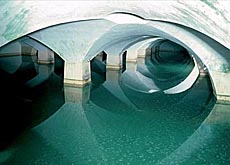Water flows through Switzerland’s history

Ever since the first Neolithic settlements were built on the shores of its rivers and lakes, water has defined Switzerland's history.
Water provided a means of irrigation and transport for the region’s earliest settlers and enabled Switzerland to develop its trade routes.
The first major watercourses in Switzerland were built as far back as the third century BC.
Some of the earliest examples include a Roman aqueduct that supplied the city of Aventicum (today Avenches in canton Vaud), while a 6.5km-long canal linked Liestal to the high-altitude city of Augusta Raurica (Augst) in canton Basel Country.
During the Middle Ages, waterways were deemed to be as important as the main thoroughfares running through Switzerland.
It was also at this time that people began to develop wells, mills and water cisterns to supply the communities that had sprung up around castles and fortresses.
Monopoly
In the cities, rivers and canals were managed by groups of boatmen who were employed by local authorities.
Officials in Basel caused a stir in the 15th and 16th centuries when they established a monopoly on the water traffic on the Reno, which was then extended beyond the city’s boundaries.
By the second half of the 19th century, the importance of water transport began to dwindle and was superseded by railways.
Railways also put paid to the trade in shipping timber from alpine valleys, which had enjoyed a short boom during the first decades of industrialisation.
Water management
It wasn’t until the 18th century that cities such as Bern and Zurich began to introduce systems of water management, setting out which wells were meant for public and private use.
Severe punishments were imposed on anyone who soiled communal water supplies or who was suspected of doing so, as contaminated water was linked to the spread of fatal diseases such as leprosy.
By the 1850s, modern irrigation systems were laid out in most parts of Switzerland; they were gradually followed by sewage works.
Paradoxically, some of the worst outbreaks of typhoid in Switzerland occurred at the same time as these sanitary advances, with epidemics sweeping through cities such as Lausanne in 1891.
It wasn’t until the discovery of the pathogenic germ for typhoid in 1906 that water became regarded as a vehicle for transmitting diseases.
Home plumbing
During the first part of the 20th century, larger, urban households began to install plumbing facilities. People living in rural areas had to wait until after the Second World War to enjoy the same luxury.
With improved plumbing facilities came tap water consumption, which in turn triggered legislative changes to protect water quality and the environment.
swissinfo, Andrea Tognina
Waterways helped Switzerland’s earliest settlers to develop trade routes.
The first major watercourses were built in the third century BC.
During the Middle Ages, waterways were considered as important as the main thoroughfares.
In the 18th century major Swiss cities set up systems of water management.
By the 1850s modern irrigation systems were laid out in most of Switzerland: eventually they were replaced by sewage works.
During the first part of the 20th century, urban households began installing indoor plumbing.

In compliance with the JTI standards
More: SWI swissinfo.ch certified by the Journalism Trust Initiative








You can find an overview of ongoing debates with our journalists here . Please join us!
If you want to start a conversation about a topic raised in this article or want to report factual errors, email us at english@swissinfo.ch.